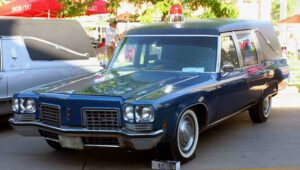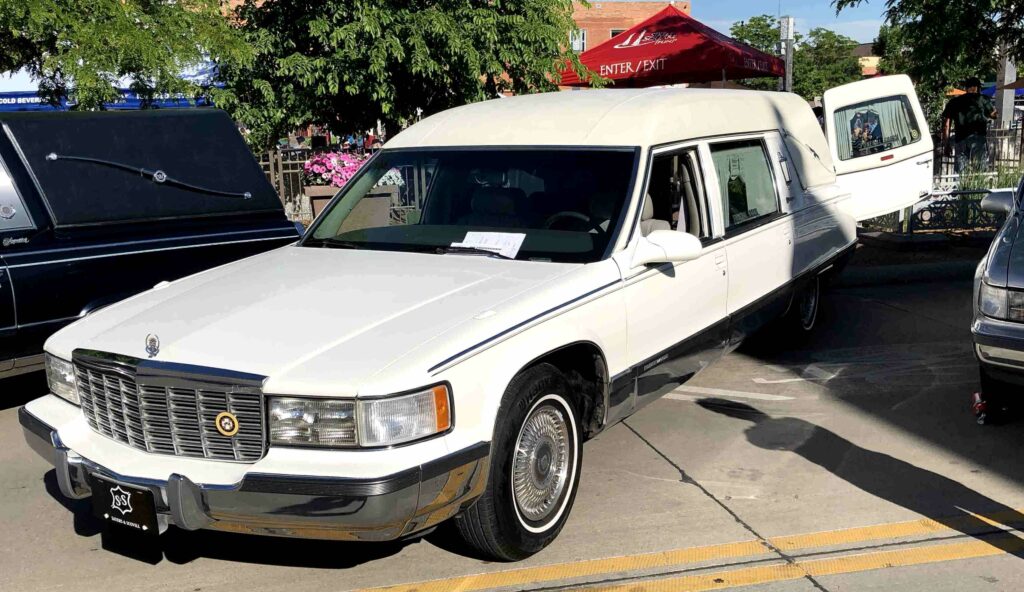
Writing almost a decade ago for Hemming Classic Car, an author concluded that “[s}adly, by the early 1930s, the custom coachwork era was ending, and it was all but gone by the time World War II erupted.” He just wasn’t looking in the right places. Elegant bespoke bodywork crafted on luxury car chassis, including Cadillac, Packard, and Lincoln, survived the War. It was constructed by coachbuilders including Eureka, Superior, Sayers & Scoville/Hess & Eisenhardt, Henney, Miller-Meteor, Sovereign, and others. These are the vehicles shown at the Professional Car Society Concours d’Elegance held in Rapid City, South Dakota, in June in conjunction with the Society’s annual International Meet. That’s right: hearses, ambulances, and limousines.
The Society’s definition of a “professional car” is “a funeral, livery, or ambulance class vehicle having special coachwork executed on passenger car styling.” These were, and still are, built by specialty manufacturers. The most common chassis is Cadillac, largely because General Motors for many years produced a factory limousine, the Fleetwood 75, and companion “commercial chassis” specifically designed for hearses, flower cars, and ambulances. Even so, professional cars were constructed on other chassis. In the late 1940’s and early 1930’s, Henney built hearses and ambulances on Packard chassis.

In the 1960’s, Lehmann-Peterson – which today constructs Cadillac XTS extended sedans – built executive limousines on Lincoln chassis. In the 1980’s, as Lincoln attempted to compete more vigorously for the luxury car market, hearses were constructed on the Town Car chassis. Manufacturers of professional cars also based hearses and ambulances on Buick, Oldsmobile, and Pontiac chassis.

Though hearses are the most common professional car, ambulances are the most colorful. When these vehicles dominated emergency medical transport, ambulance services were typically operated by private companies and, in many instances, by the same company that operated a funeral parlor. There was glamour to the ambulance of that bygone era. In September of 1969, the television drama “Medical Center” debuted on NBC. The show’s opening credits featured a musical theme mimicking the rising sound of a siren as the television screen showed a 1970 Cadillac ambulance rushing through the city’s streets to the hospital. (You can watch it on You Tube.)

Such an ambulance was on display at the Professional Car Society Concours d’Elegance, as pictured at the top of this post. It is a “high top” – meaning that the roof is elevated above the rear compartment – constructed by Miller Meteor on a 1974 Cadillac commercial chassis.
In smaller cities, purchasing and operating separate vehicles for funeral and ambulance service was cost prohibitive. To meet the needs of that market, companies manufacturing professional cars created the “combination coach,” or just “combination. This is a vehicle that can be configured as either hearse or ambulance. Though sometimes painted in the customary black associated with hearses, “combinations” were often painted in other, albeit subdued, colors. “Combinations” were built “limousine style,” which means the side windows extend the entire length of the vehicle. Hearses were often built “landau style, with closed side panels behind the rear doors that featured a large landau bar. “Combinations” could be were equipped with rooftop rotating roof beacons that could show red light for ambulance duty or yellow light for funeral processions.
Inside, “combinations” could change configuration quickly. Configured as an ambulance, the gurney would be positioned to the side, behind the driver. Seats that folded from the floor or panel behind the driver’s compartment, or could be quickly installed, allowed medical personnel to administer to the patient during transit. With the seats and gurney folded away or removed, the entire rear compartment could accept a casket in the same manner as a normal hearse.

The Concours featured two “combination coaches,” including a beautifully presented 1969 Cadillac and a 1972 Oldsmobile 98.

1972 was also the year that Jack Webb (famous for the early television series “Dragnet” and later producer of many popular shows, including the police drama “Adam 12”) brought a new weekly series dramatizing emergency medicine to national television. “Emergency” featured paramedics trained to providing treatment at the scene and able to communicate with hospital emergency rooms while en route with the patient. These paramedics did not use conventional ambulances on automotive chassis. They were not merely transporting a patient to the hospital. They were taking the hospital’s emergency room to the patient. For that, they needed the space for equipment that could only be provided by an emergency vehicle built on a truck platform. (The vehicle used in filming the series is now displayed at the Los Angeles County Fire Museum.)
“Emergency” transformed the public’s view of emergency medicine. Though the emergency medical services depicted in the show were then available in only a few metropolitan areas, demand for similar services developed nationally as the weekly drama demonstrated the life-saving abilities of paramedics. More and more communities began adding EMTs to fire departments, displacing private ambulance services. By the end of the decade, the automobile-based ambulance was a part of professional car history. Reportedly, the last was built in 1979.
The market remained, however, for funeral and livery professional cars.

Magnificent examples of these were also shown at the Society’s Concours event.

Cadillac traditionally dominated the market for hearses, flower cars, and six door funeral limousines. Cadillac produced a “commercial chassis” specifically designed to accept professional car coachwork until 1997, when it switched its passenger car line from body-on-frame to unibody construction. Through 1984, this was a true chassis only – a frame with the engine, transmission, steering suspension, driveshaft and rear axle installed and front bodywork in place – exactly as the classic era marques, such as Duesenburg, Rolls-Royce, Packard and others supplied their chassis to the custom body makers of the day, including LeBaron, Brunn, Rollson, and the others whose passing the Hemmings author mourned. The front seat, rear fenders, rear bumper and other supplied parts were boxed and shipped with the chassis to the company that would construct and mount the body. (Prior to 1955, Packard supplied similar commercial chassis to Henney.)

After 1884, Cadillac’s commercial chassis was essentially a completed passenger car, but with the rear portion behind the center pillar left unfinished. Body builders were now responsible for cutting and lengthening the vehicle, modifying the rear structure, and then crafting the bodywork and interior.

When Lincoln entered the funeral car market in the 1980’s, they supplied Town Cars to professional car manufacturers for funeral conversion. A 1996 Lincoln hearse was shown at the Concours (along with the original window sticker displaying a price of over $60,000 – about $20,000 more than a new Town Car sedan). Only two were built to this design, though other bodybuilders produced similar Lincoln hearses.
Should you be in the market for a new professional car, Cadillac continues to market vehicles specifically designed for modification into funeral cars: option codes W30 for the Extended Sedan, V4U for the Limousine, and B9Q for the Hearse. Cadillac describes these as “specifically engineered, designed and built for heavy-duty application and coachbuilder conversion.” They are supplied only to body builders designated as “Cadillac Master Coachbuilders.” (These cars are currently offered on the XTS platform, which will be discontinued in October. General Motors has not yet announced a commercial chassis option for the CT6, and has yet to confirm a new assembly plant for that model, as noted in a previous Automobile Chronicles post.)

When you view any professional car, including the magnificent array shown by members of the Professional Car Society at their Concours d’Elegance, you truly are viewing vehicles individually styled and custom crafted to the highest standards, the product of today’s finest coachbuilders.
Membership in the Professional Car Society is open to anyone with appreciation of professional vehicles – you don’t have to own one to join. Its members are enthusiastic and friendly. Before you know it, you’ll probably find yourself scouring the online ads for your own coach.
There is just something about a hearse that’s irresistible.

